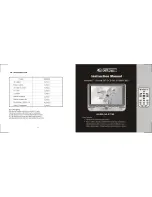
Smart Generators Operating Instructions
SG12003
THROTTLE OPEN IN AN ATTEMPT TO
GENERATE MORE ELECTRICAL
CURRENT; EQUIPMENT DAMAGE OR
PERSONAL INJURY MAY RESULT.
CHECKING ENGINE OIL:
Check oil level before each operation
and ensure that it is maintained per
Preparing the Generator; Engine Oil
Capacity section.
CHANGING ENGINE OIL:
Change oil after the first 20 hours of
operation. Thereafter it should be
changed every 100 hours.
1. Make sure the unit is on level
ground.
Drain the used oil when the engine
is warm. Warm oil drains quickly and
completely.
2. Stop the engine.
3. Place a suitable container below
the engine to catch the used oil, then
remove the filler cap, drain bolt and
washer.
Oil being drained may be hot. To reduce
the risk of burn injury, handle with care.
Dispose of used oil properly.
4. Allow the used oil to drain
completely, then reinstall the drain bolt
and washer, and tighten the drain bolt
securely.
Dispose of used motor oil in a manner
that is compatible with the
environment. We suggest you take
used oil in a sealed container to
your local recycling center or service
station for reclamation. Do not throw it
in the trash, pour it on the ground, or
down a drain.
5. With the engine in a level position,
fill to the upper limit mark on the
dipstick with the recommended oil.
NOTE: Running the engine with a low oil
level can cause engine damage.
The Oil Alert system (applicable types)
will automatically stop the engine before
the oil level falls below the safe limit.
However, to avoid the inconvenience of
an unexpected shutdown, fill to the upper
limit, and check the oil level regularly.
6. Remove filler cap and refill with
new oil.
7. Reinstall the filler cap and dipstick
securely.
AIR CLEANER:
RISK OF FIRE OR EXPLOSION. DO NOT
USE GASOLINE OR LOW FLASH-POINT
SOLVENTS TO CLEAN THE ELEMENT.
CLEAN THE ELEMENT IN A WELL
VENTILATED AREA. ENSURE THAT NO
SPARKS OR FLAMES ARE NEAR THE
WORKING AREA, THIS INCLUDES ANY
APPLIANCE WITH A PILOT LIGHT. NEVER
RUN THE ENGINE WITHOUT THE AIR
FILTER, SERIOUS DANGER CAN RESULT.
Check the air cleaner daily or before
starting the engine. Check for and
correct heavy buildup of dirt and
debris along with loose or damaged
components.
1. Release the four latch tabs or
remove the wing nut from the air
cleaner cover, and remove the cover.
2. Remove the foam filter from the
cover.
3. Remove the paper filter from the air
cleaner case. (if applicable)
4. Inspect air filter elements, and
replace if damaged.
5. Clean the air filter elements if they
are to be reused.
FOAM FILTER ELEMENT:
Wash the foam filter element in warm
water with detergent. Rinse the foam
filter element thoroughly until all
traces of detergent are eliminated.
Squeeze out excess water, but do not
wring. Allow the foam filter element to
air dry. Saturate the foam filter
element with new engine oil. Squeeze
out all excess oil. DO NOT put engine
oil on the foam damper.
NOTE: Clean the foam filter element every
25 hours of operation (more often under
extremely dusty or dirty condition)
PAPER AIR CLEANER ELEMENT:
Do not wash the paper element or use
pressurized air, as this will damage
the element. Clean by gently tapping
the element to remove dust. Replace
the element if damaged, bent or
extremely dirty. Handle new element
carefully; do not use if the sealing
surfaces are bent or damaged.
NOTE: Replace the paper element
every 100 hours (more often under
extremely dusty conditions.)
6. Wipe dirt from the inside of the air
cleaner body and cover, using a
moist rag. Be careful to prevent dirt
From entering the air chamber that
leads to the carburetor.
7. Place the foam air filter element
in the air cleaner cover. If
applicable, reinstall the paper air
filter element and cover to the air
cleaner case. Replace cover
securely.
5



























